Special Report: Platform Drugs—Marketing Your Opportunities
Pharmaceutical Executive
Tracking business by indication is critical for evaluating market performance and making accurate resource allocations
As mega-blockbusters like Lipitor and Plavix approach the end of their runs, the pharmaceutical industry is scrambling to replace the big revenue streams that are drying up almost instantaneously. So far, R&D efforts have proven none too successful. In 2007, FDA approved only 18 new chemical entities; only twice in the past thirty years has there been a smaller number of approvals.
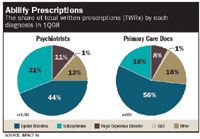
Abilify Prescriptions
Discovering new compounds and getting them to market has clearly become more difficult. One strategy the pharmaceutical industry is using to address its productivity crisis is to find new uses for drugs that have already made it through to the marketplace. In the good old days, pharma companies typically pursued marketing approval for a single indication for a new medicine. In the last few years, however, they are increasingly exploring all possible uses for promising new compounds in order to gain approval to market the same drug for multiple indications—and improve the return on their R&D investment.
"We are being much more rigorous and disciplined in evaluation of the likely potential of any compound across multiple indications," Pfizer's vice president of global medicine, Steve Romano, told the Newark Star-Ledger earlier this year. "The mechanisms we're pursuing...can have an effect across a number of disease states."
Multiple Indications: A Routine Strategy
FDA seems to be supportive of this approach. After all, olatform drugs make sense. Once a product's safety is established in the first approved indication, the agency can generally be more secure that no serious unexpected safety issues will arise in a second or third indication. In fact, the number of expanded indications for biotech drugs doubled in the first half of this decade: from 2000 to 2003, 29 got the nod; from 2004 to 2006, 58 did.

The Pain Market
Genentech's Avastin (bevacizumab) is an even more recent example. In February, amidst considerable controversy, FDA cleared the TVEGF-inhibitor—already approved to treat lung and colorectal cancer—for breast cancer, based solely on the drug's ability to slow tumor growth. This action went against both the recommendation of the advisory panel and its traditional requirement that a cancer drug demonstrate that it can extend, or improve the quality of, a patient's life.
TNF inhibitors, a category of biologics that includes Amgen's Enbrel (etanercept), Abbott's Humira (adalimumab), and Centocor's Remicade (infliximab), have either been approved, or are knocking on the door to treat a variety of autoimmune conditions such as rheumatoid arthritis, psoriasis, and Crohn's disease.
So brand extension is a revenue enhancement strategy that seems to be working for the pharmaceutical industry, although it presents certain challenges. The choice of a first indication is all important, and the development program should be managed to ensure that the initial approval provides a strong platform for additional indications. For example, companies developing compounds to treat multiple indications including obesity should think twice before committing to obesity first. They'll probably be better off focusing on an indication recognized as a medical (rather than a lifestyle) condition because securing reimbursement for weight loss is much more difficult than, for example, diabetes—as illustrated by Roche's troubles with Xenical (orlistat).
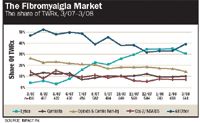
The Fibromyalgia Market
Another challenge with a platform drug strategy is one of public perception. The approach has been criticized as simply another ploy by pharmaceutical companies to make up for, if not cover up, a lack of R&D innovation. Insurers may view it as nothing more than an effort to maximize revenues. But both perceptions are a bit unfair. While they are by no means breakthrough drugs, the extended indications endure the same clinical and regulatory rigor as new, single-indication chemical entities, as well as offering patients new treatment options.
Prescribing Data: Right From the Source
Doctors are free to use approved medicines off label, but drugmakers are unable to promote these unapproved uses. Hence, the broader a drug's label, the more freedom sales and marketing have in promoting the drug.
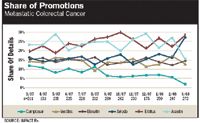
Share of Promotions
As labels expand, a company's ability to track brand promotion and prescribing by indication becomes increasingly important. The data generated by ImpactRx's information network of more than 3,500 physicians demonstrates the growing importance of performance measurement by indication.
ImpactRx utilizes smart phone technology to collect treatment information at the ICD-9 diagnosis code level directly from its network physicians. Because this data capture takes place at the point of treatment in the doctor's office—and prior to any coding intervention for billing and insurance purposes—ImpactRx is able to obtain a uniquely accurate read on physician prescribing patterns at the diagnosis level.
A clear breakdown of business by indication is imperative for effectively evaluating market performance, and for making insightful resource allocation decisions. It's important that a marketing team understands, with as much granularity as possible, how physicians are using its brand—both on and off label.
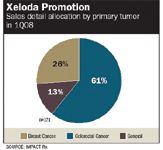
Xeloda Promotion
The atypical antipsychotic market illustrates how important information on brand usage by diagnosis is to managing the business of a multi-indication category. Drugs such as Bristol-Myers Squibb's Abilify (aripiprazole), AstraZeneca's Seroquel (quetiapine), and Lilly's Zyprexa (olanzapine) are approved to treat a variety of neurological disease states such as bipolar disorders and schizophrenia. A breakdown of the prescriptions written for Abilify in the first quarter of 2008 by both psychiatrists and primary care physicians demonstrates they clearly use the drug differently (Figure 1, page 105). Schizophrenia accounts for more than 30 percent of Abilify's usage by psychiatrists, compared to only 18 percent of primary care doctors' usage. Conversely, bipolar disorders represent 56 percent of primary care usage of Abilify and less than 45 percent of prescriptions written by psychiatrists. (This breakdown is only logical—schizophrenia represents a larger percentage of specialists' prescribing, given the severity, complexity, and chronic nature of the disease.) In order to effectively manage Abilify's performance, the brand team needs to know how these business breakdowns by physician specialty compare to both the market opportunity for, and the resources allocated to, each indication.

Share of Prescriptions
Creating a New Market: The Case of Fibromyalgia
Traditional retail, prescription-based market share measures compare a brand's total usage to that of its key competitors—regardless of the diagnoses for which the products were prescribed. But for products with multiple indications, marketing and sales teams need this condition-specific level of detail about their brand's performance. In certain situations, competitors will vary by indication, and the ability to drill down into market share within each diagnosis will provide a truer picture of brand performance.
Fibromyalgia is a chronic, widespread pain condition that has attracted a great deal of attention of late. It is difficult to diagnose because its symptoms are often confused with those of other pain-related conditions, as well as depression. Despite the diagnostic uncertainty—and controversy in the media—the FDA, the American College of Rheumatology, and insurers all recognize fibromyalgia as a legitimate medical condition. According to industry analysts Cowen and Company, fibromyalgia may affect as many as 12 million Americans—an indication of its major market potential.
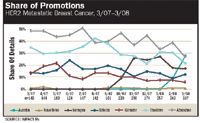
Share of Promotions
Although Lilly's anti-depressant Cymbalta (duloxetine) is in active pursuit of approval for use in fibromyalgia, Lyrica (pregabalin)—originally marketed for two types of neuropathy—remains the only treatment for the condition since is approval in June 2007. The company is also chasing additional indications for the drug, including epilepsy. (Forest and Cypress are co-developing minalcipran for fibromyalgia; approval is not expected until 2009.)
Although it represents a major source of the pain market's growth, fibromyalgia today accounts for only a small proportion of the market's total prescribing (Figure 2). Among primary care doctors, this broadly defined market (from acute to musculoskeletal to neuropathic diagnoses) is dominated by older products such as opiods, COX-2s, and NSAIDs. Lyrica, by contrast, has generated shares in the low single digits.
To get a true read on how primary care physicians are treating fibromyalgia—and how they are responding to Pfizer's six-months-old promotional push for its drug—it's necessary to track market share by diagnosis (Figure 3).
At this level of detail, the picture changes dramatically. Lyrica's share of prescriptions written by primary care doctors leaps from 2 to 3 percent for all diagnoses (on or off label) to 30 to 35 percent—showing clear potential for market leadership in fibromyalgia.
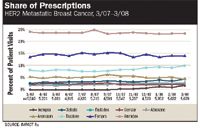
Share of Prescriptions
Tracking Market Penetration: The Case of Xeloda
Given that they are often making treatment decisions for patients in life-threatening situations, oncologists have traditionally been among the most experimental physicians when utilizing treatment alternatives. The oncology market is currently the most competitive category in the industry, and the most successful cancer drugs, such as Genentech's Avastin and Sanofi's Taxotere (docetaxel), are typically approved to treat more than one tumor type. Roche's Xeloda (capecitabine) is approved to treat both metastatic colorectal and breast cancer—two distinctly different markets that share the same specialist. Once again, to fully leverage the overall market opportunity for Xeloda, Roche's brand team needs an objective analysis of both the promotional investment in each indication and the physician response to that investment. In the first quarter of this year, approximately 61 percent of Xeloda's details were directed toward its colorectal cancer indication, and 26 percent for breast cancer.
A translation of this detail allocation to the marketplace reveals the competitive dynamics of these two markets (Figure 5, page 108). In March 2008, Xeloda's share of colorectal cancer-specific details to oncologists jumped from an average of 15 percent to 27 percent—evidence that Xeloda captured the majority of the attention of the oncologists vacated by Avastin as that brand shifted its focus to its new breast cancer indication.
Xeloda's share in the breast cancer market is limited to patients who are HER2 negative. Its share of HER2 negative breast cancer details also averaged about 15 percent prior to the launch of Bristol-Myers Squibb's Ixempra (ixabepilone), an HER2 competitor, in October. But with the entry of Ixempra and, more recently, Avastin, Xeloda's details share fell to approximately 11 percent in March.
Roche allocates more than double the amount of internal resources to Xeloda's colorectal indication than to its breast cancer indication. In March, Xeloda's share of details versus its competitors in the colorectal market was more than double its detail share in the breast cancer market. This confirms that their internal allocation is well aligned with the market.
Ultimately, what matters is not how resources are allocated, but how physicians respond to the resources directed toward them. Tracking Xeloda's level of penetration into the colorectal and breast cancer markets—as defined by percentage of patient visits in which the drug is used—confirms this insight (Figure 6, page 110). Xeloda's share of usage is consistent with its share of details in each tumor type—more usage and detail share in colorectal and the converse in the breast cancer market.
Of course, there's more to the Xeloda story than this. The size of the market opportunity, the brand's efficacy and safety compared to its competitors, and the amount of resources invested by the competition in launching or growing their brand are all factors Roche must consider in managing Xeloda. To do this to its fullest potential, the brand team needs to know—in as close to real time as possible—the hard facts of its business by indication. How should Roche react to the entry of Avastin into breast cancer by the oncology market leader, Genentech? (There may be no need for any reaction, as Roche already owns most of Genentech!) Should promotional resources be added, or simply shifted, from the colorectal cancer indication? Pharma's current belt-tightening climate leaves little margin for error in making such decisions.
The challenges of managing multiple indications for the same brand will increase as more and more platform drugs emerge. The brand increasingly represents an extendable franchise opportunity not unlike a consumer packaged good, and marketing teams will no longer be able to manage it as a single entity. They must be able to plan and execute marketing strategy (and measure performance) at the indication level to maximize returns from their increasingly precious brand assets.
Patrick Angelastro is a senior vice president of strategic development at ImpactRx, Inc. He can be reached at PAngelastro@Impactrx.com.

Addressing Disparities in Psoriasis Trials: Takeda's Strategies for Inclusivity in Clinical Research
April 14th 2025LaShell Robinson, Head of Global Feasibility and Trial Equity at Takeda, speaks about the company's strategies to engage patients in underrepresented populations in its phase III psoriasis trials.
Beyond the Prescription: Pharma's Role in Digital Health Conversations
April 1st 2025Join us for an insightful conversation with Jennifer Harakal, Head of Regulatory Affairs at Canopy Life Sciences, as we unpack the evolving intersection of social media and healthcare decisions. Discover how pharmaceutical companies can navigate regulatory challenges while meaningfully engaging with consumers in digital spaces. Jennifer shares expert strategies for responsible marketing, working with influencers, and creating educational content that bridges the gap between patients and healthcare providers. A must-listen for pharma marketers looking to build trust and compliance in today's social media landscape.